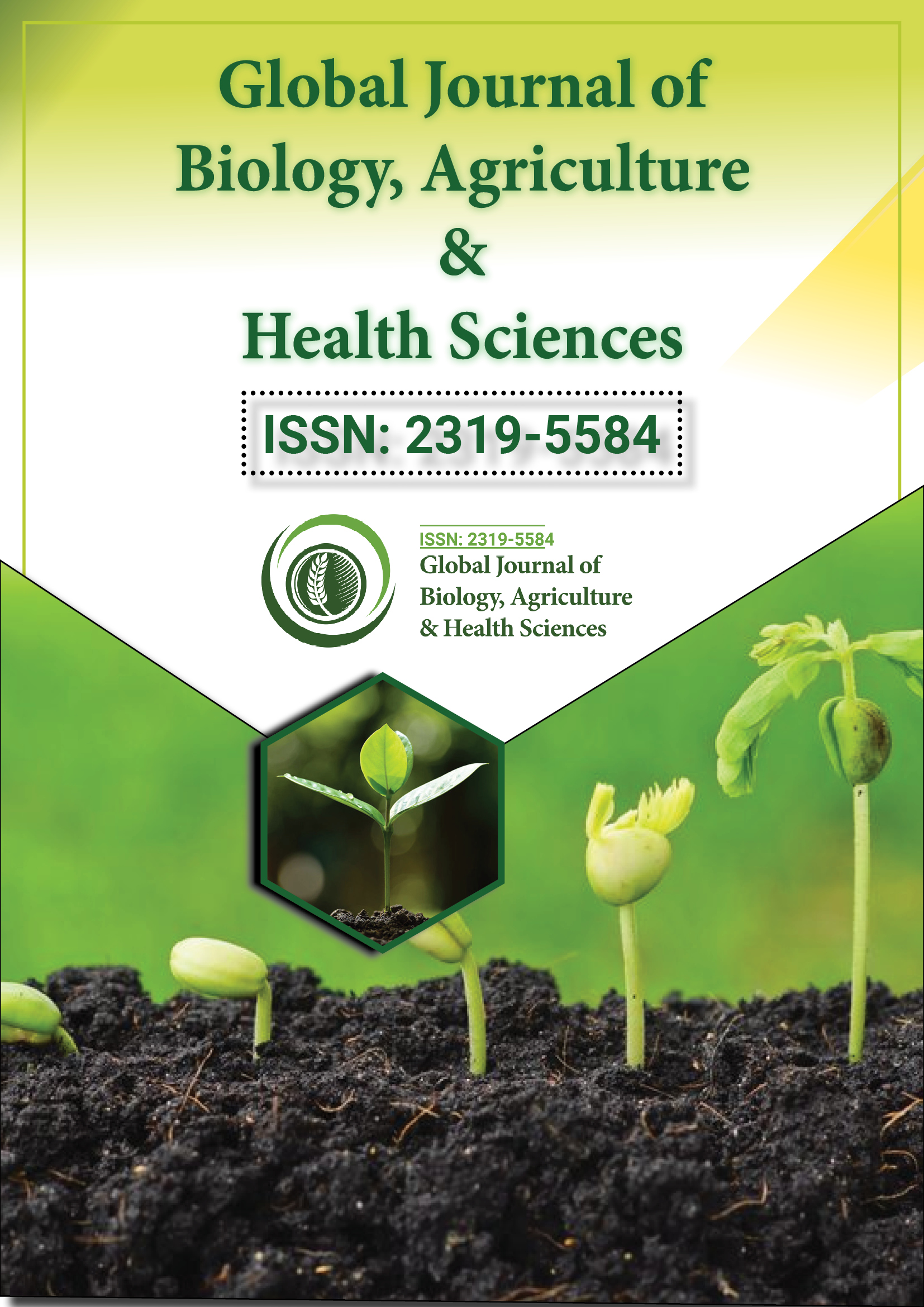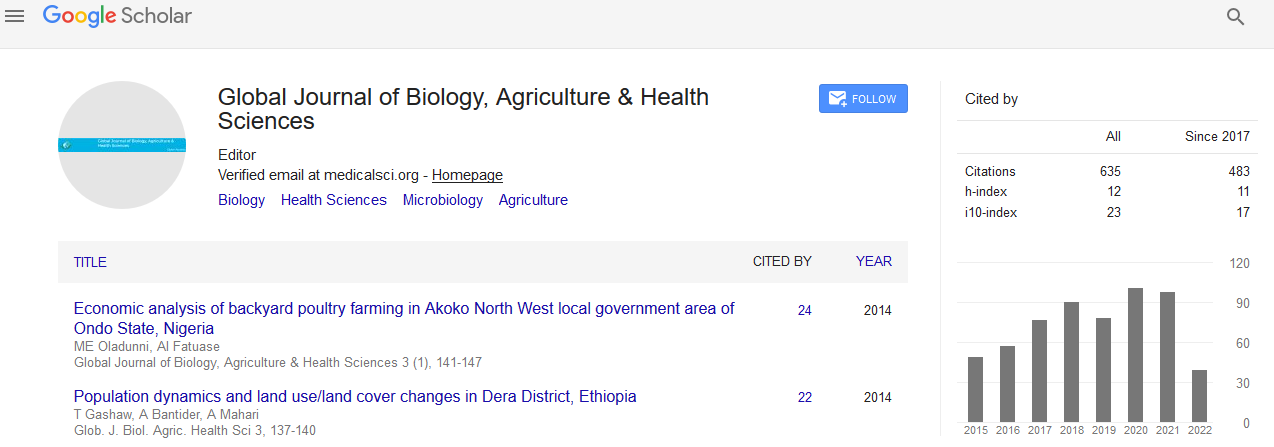Indexed In
- Euro Pub
- Google Scholar
Useful Links
Share This Page
Journal Flyer

Open Access Journals
- Agri and Aquaculture
- Biochemistry
- Bioinformatics & Systems Biology
- Business & Management
- Chemistry
- Clinical Sciences
- Engineering
- Food & Nutrition
- General Science
- Genetics & Molecular Biology
- Immunology & Microbiology
- Medical Sciences
- Neuroscience & Psychology
- Nursing & Health Care
- Pharmaceutical Sciences
Opinion Article - (2024) Volume 13, Issue 4
Innovations in Developing Resilient Crops through Mutagenesis and Genome Engineering
Schulz Goodwin*Received: 27-Nov-2024, Manuscript No. GJHABS-24-28143; Editor assigned: 29-Nov-2024, Pre QC No. GJHABS-24-28143 (PQ); Reviewed: 13-Dec-2024, QC No. GJHABS-24-28143; Revised: 20-Dec-2024, Manuscript No. GJHABS-24-28143 (R); Published: 27-Dec-2024, DOI: 10.35248/2319-5584.24.13.235
Description
Plant breeding is a critical component of agriculture, as it allows the development of crop varieties with improved characteristics such as higher yields, resistance to diseases and better nutritional content. Traditional plant breeding methods have long been employed to achieve these objectives by selecting desirable traits from a variety of plants and crossbreeding them. However, with the rapid advancements in biotechnology and molecular biology, new approaches have been developed to accelerate the breeding process and enhance the genetic diversity of crops. Among these methods, mutagenesis-based plant breeding and genome engineering have emerged as powerful tools for developing crops with specific, beneficial traits. These techniques have revolutionized the way plant breeding is conducted and offer a wide range of applications in agriculture.
Mutagenesis refers to the process by which the genetic material of an organism is altered through physical, chemical, or biological agents. In plant breeding, mutagenesis is used to induce genetic variation, which is then exploited to select plants with desirable traits. This approach has been widely used for decades to create new plant varieties with improved characteristics.
Spontaneous mutagenesis occurs naturally, through errors in DNA replication or environmental factors like radiation, while induced mutagenesis involves the deliberate application of mutagens, such as chemicals or radiation, to induce mutations in the plant’s genome.
Chemical mutagenesis involves the use of chemicals such as Ethyl Methane Sulfonate (EMS) or sodium azide, which alter the DNA structure and introduce mutations. This technique has been widely used in breeding programs because it is relatively simple, cost-effective and applicable to a wide range of plant species.
Radiation mutagenesis, on the other hand, uses ionizing radiation like X-rays, gamma rays, or neutrons to break DNA strands and induce mutations. Radiation mutagenesis has been particularly useful in crops that are less amenable to chemical mutagens.
Another form of mutagenesis is biological mutagenesis, which involves the use of microorganisms such as bacteria or viruses to introduce mutations into plant genomes. This method is less commonly used but can be effective in certain cases.
Mutagenesis-based breeding has been applied to numerous crops to improve traits such as disease resistance, drought tolerance and nutritional content. One of the main advantages of mutagenesis is the ability to induce a broad range of genetic variation in a population. This allows breeders to screen for novel traits that would not necessarily arise through traditional breeding methods.
For example, mutagenesis has been used to create new varieties of rice with improved resistance to bacterial blight, a disease that severely affects rice crops. Similarly, mutants of wheat with resistance to rust diseases have been developed using radiation mutagenesis. Other crops, such as tomatoes, maize and barley, have also benefited from mutagenesis-based breeding, with new varieties exhibiting improved yield, flavor and pest resistance.
In addition to enhancing crop resilience, mutagenesis has been used to improve the nutritional content of plants. For example, plants with elevated levels of vitamins, minerals and antioxidants have been developed using chemical mutagenesis. These enhanced crops contribute to food security and human health by addressing nutritional deficiencies.
While mutagenesis-based plant breeding offers many benefits, it also comes with challenges. One of the major limitations is the unpredictability of mutations. Unlike traditional breeding, where the traits of interest are controlled through selective crossbreeding, mutagenesis can lead to unintended changes in the plant genome. These unintended changes can sometimes result in undesirable traits or a loss of beneficial characteristics.
Moreover, mutagenesis does not always lead to the desired trait in every plant. For each mutation that induces the desired change, numerous other mutations may have neutral or negative effects. This can make the process time-consuming, as breeders must screen large populations to identify successful mutants.
Despite these challenges, mutagenesis remains a valuable tool in plant breeding, particularly when combined with other methods like genetic mapping and marker-assisted selection, which help identify desirable traits more efficiently.
Genome engineering refers to the precise modification of an organism’s genetic material using molecular techniques. Unlike mutagenesis, which induces random mutations, genome engineering allows for the targeted modification of specific genes within a plant’s genome. This precision makes genome engineering a powerful tool in modern plant breeding, as it enables the development of crops with specific traits in a much more controlled manner.
The most widely used genome engineering tool is CRISPR-Cas9 (Clustered Regularly Interspaced Short Palindromic Repeats). CRISPR-Cas9 is a naturally occurring bacterial defense mechanism that has been adapted for genome editing in a variety of organisms, including plants. The CRISPR system uses a guide RNA to direct the Cas9 enzyme to a specific location in the genome, where it introduces a cut in the DNA. This cut can then be repaired in a way that either disables a gene or introduces a new genetic sequence, allowing for precise alterations in the plant genome.
Citation: Goodwin S (2024). Innovations in Developing Resilient Crops through Mutagenesis and Genome Engineering. Glob J Agric Health Sci. 13:235.
Copyright: © 2024 Goodwin S. This is an open-access article distributed under the terms of the Creative Commons Attribution License, which permits unrestricted use, distribution, and reproduction in any medium, provided the original author and source are credited.

